 |
RONRIDENOUR.COM |
 |
RONRIDENOUR.COM |
| Home |
| About Ron Ridenour |
| Articles |
| Themes |
| Poems |
| Short stories |
| Books |
| Links |
| Search |
| Contact |
| Dansk |
| Español |
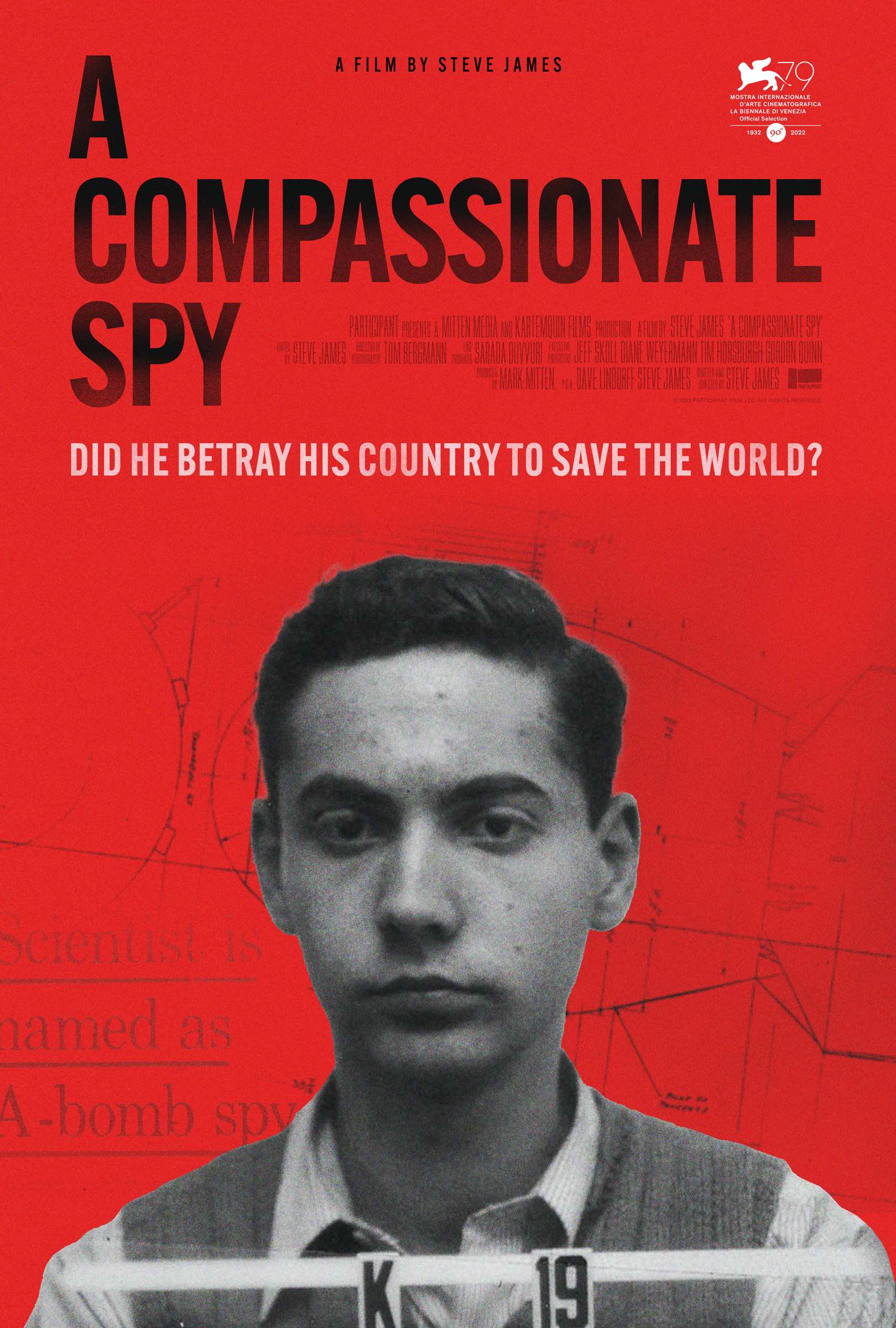 Film
poster shows Ted Hall. His badge number at Los Alamos is K-19
Film
poster shows Ted Hall. His badge number at Los Alamos is K-19
The provocative documentary, “A Compassionate Spy”,
Reveals How Ted Hall Saved The Russian People From A Treacherous U.S.
Sneak Attack In 1950-51—And May Well Have Prevented A Global Nuclear
Holocaust
“A Compassionate Spy” tells the amazing but almost unknown
story of a “near-genius” Harvard physics major, who at age
17, was selected to help develop an atom bomb before the Nazis did.
At 18, after graduating from Harvard, Ted was the youngest physicist
to work on the atomic bombs at Los Alamos, New Mexico. He worked with
uranium and the implosion system for the plutonium bomb used in the
Trinity test on July 16, 1945, one month before that bomb type killed
tens of thousands of civilians at Nagasaki.
Between the bombings at Hiroshima, August 6, and Nagasaki, August 9,
somewhere around 200,000 civilians were murdered, and a similar number
died within some months of radiation sickness and injuries.
The film also illustrates why and how Ted shared his knowledge with
Soviets: to prevent a post-war U.S. perhaps heading towards fascism
and/or world domination intoxicated by having a nuclear monopoly. He
foresaw correctly, because by 1946 Wall Street bankers and weapons industrialists
had convinced President Harry Truman to produce 300-400 more atomic
bombs to attack the Soviet Union in 1950-1.
Pentagon's plan called for dropping these bombs on 200 targets in
100 cities, which would have killed innumerable millions of its people.
The United States would have taken over its huge land and natural resources.

Source of Pentagon illustration of its nuclear bomb targets in the
Soviet Union courtesy of "A Compassionate Spy" producers
Nine months after beginning work on the first atomic bomb, in October
1944, Ted received leave to celebrate his 19th birthday in NYC. It was
there, he made his first contact with a Russian, Sergei Kurnakov, who
was a writer and an undercover intelligence officer. Ted gave detailed
plans for the plutonium bomb to the Russians, sometimes using his enthusiastic
friend Saville Sax, whom he roomed with at Harvard, as courier.

Saville Sax, photo by his son Boria Sax
In transmitting communication, the two novice spies used Walt Whitman’s
Leaves of Grass.
Ted’s Soviet spy code name was MLAD (youth).
Ted’s information collaborated what the Russians were receiving
independently from scientist Klaus Fuchs. So critical was this to Soviet
scientists´ ability to develop an atom bomb of their own, that
they made a virtual copy of the Nagasaki bomb, which was Ted’s
specialty. They exploded a test bomb on August 29, 1949, between two
and five years earlier otherwise expected by U.S., experts. Truman was
then forced to cancel his plans to pre-emptively invade Russia, because
retaliation by the Soviets would be likely.
(A similar dilemma faced President John F. Kennedy during the 1962 Cuban
Missile Crisis when Wall Street capitalists, the Pentagon, and the CIA,
which Truman enacted in 1947, saw a chance to annihilate Soviet peoples
in several areas. Taking over Russia had been on U.S. domination list
since it invaded Russia in summer 1918. When Kennedy chose another path,
naval blockade of Cuba, it worked. The missiles were withdrawn. Yet
Kennedy had also signed his death warrant.)
This documentary, however, is not a political film per se. Central is
the passionate, durable love story of Ted and his wife Joan, intermeshed
with the history of the atomic bomb-making, its use and near-use.
Journalist and producer Dave Lindorff initiated the film idea in 2018.
He, together with director Steve James and fellow producer Mark Mitten,
started with three days of interviews with Joan, now 93. Joan also gave
the team a video cassette, which Ted at his attorney’s suggestion
made for the “historical record”. Ted explains his reasoning
for volunteering as a Soviet asset at Los Alamos.
Lindorff received the I.F. Stone “Izzy Award” for “Outstanding
Independent Journalism” over his five-decade career and specifically
for his exposé: “Exclusive: The Pentagon’s Massive
Accounting Fraud Exposed”, The Nation, December 2018.
Steve James, two- time Academy Award nominee, was called “Chicago’s
documentary poet laureate,” by The Hollywood Reporter in its September
2 review of the first film showing, which took place at the Venice Film
Festival. One thousand viewers filling the Lido Hall rose to applaud
for five minutes at its conclusion. A day later, the U.S. premiere was
held in four full theaters at Colorado’s Telluride Film Festival.
So far, the film has been presented at six U.S. and European film festivals
with at least two more to come. The funding comes from Participant Media,
which is receiving bids for wide distribution.
This reviewer, and my companion-photographer, Jette Salling, saw the
film in Cambridge where Joan and Ted lived from 1962 until his death
in 1999. She still lives in the same house.
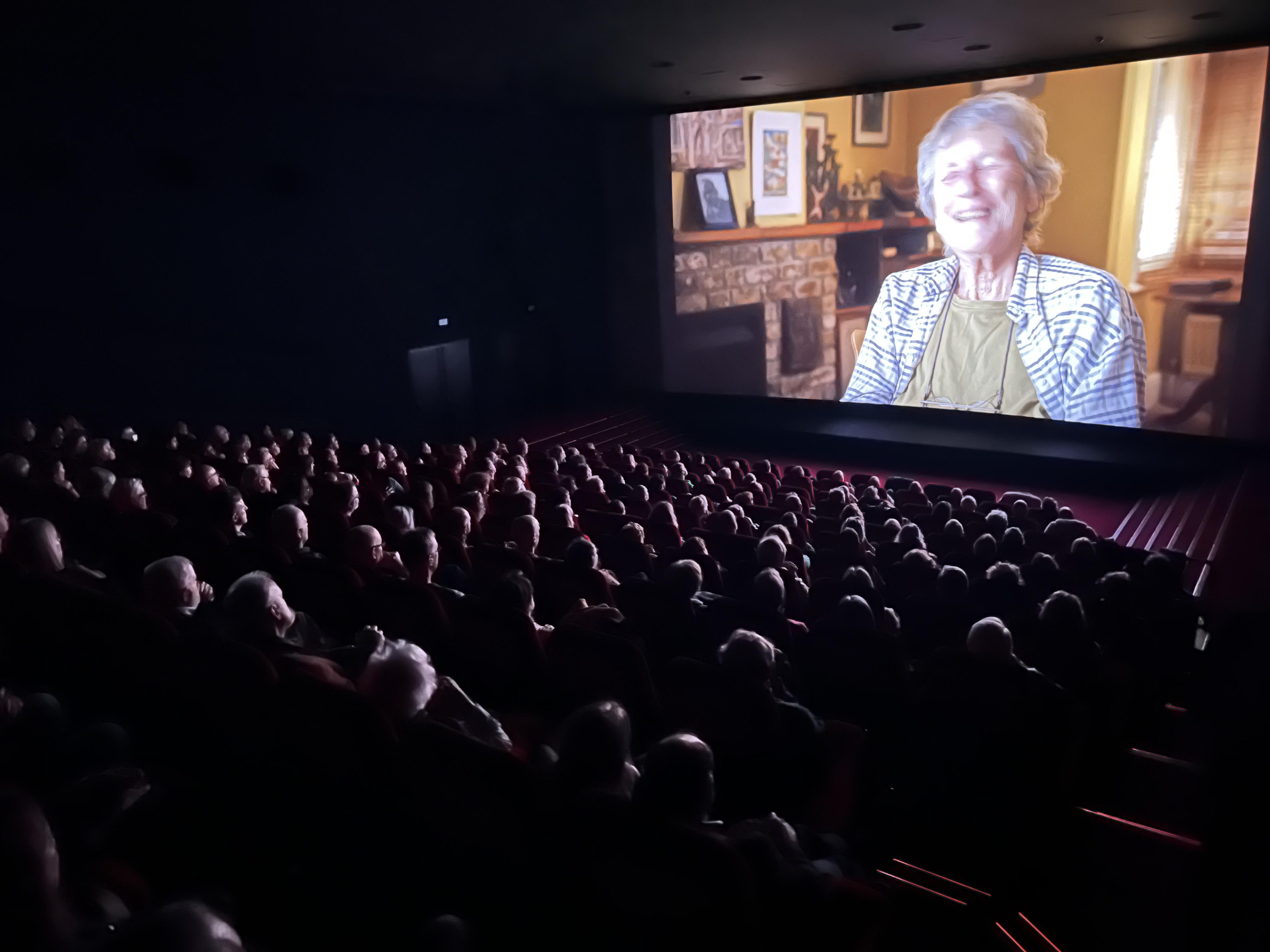
Joan Hall in film presented October 22 at Cambridge Film Festival
to a nearly full theatre.
Although I am not a professional film reviewer, my six decades of peace
and racial equality activism, and five decades of professional journalism
lead me to the conclusion that, “A Compassionate Spy”
is the most horrendous and greatest of all films ever made.
Horrendous, because the United States of America, propounding to be
the greatest democracy in the world, the greatest freedom-loving country,
murdered hundreds of thousands of Japanese civilians without any iota
of “need”.
Horrendous, all the more, because the USA elite and their politicians
callously targeted millions more to die in the Soviet Union just as
WWII was won, primarily by the Russians.
Greatest, because of what two men, Ted Hall, and Klaus Fuchs (later
down) did to prevent the genocidal action. Ted, and a handful of other
scientists and couriers, deserve world-wide recognition by all humans
who have any sense of brotherhood, sisterhood, solidarity, and world
peace.
One of the last public statements Ted Hall made just before he died
was to encourage the next generations to demand government policies
that do not put the world at such risk again.
FILM sequences
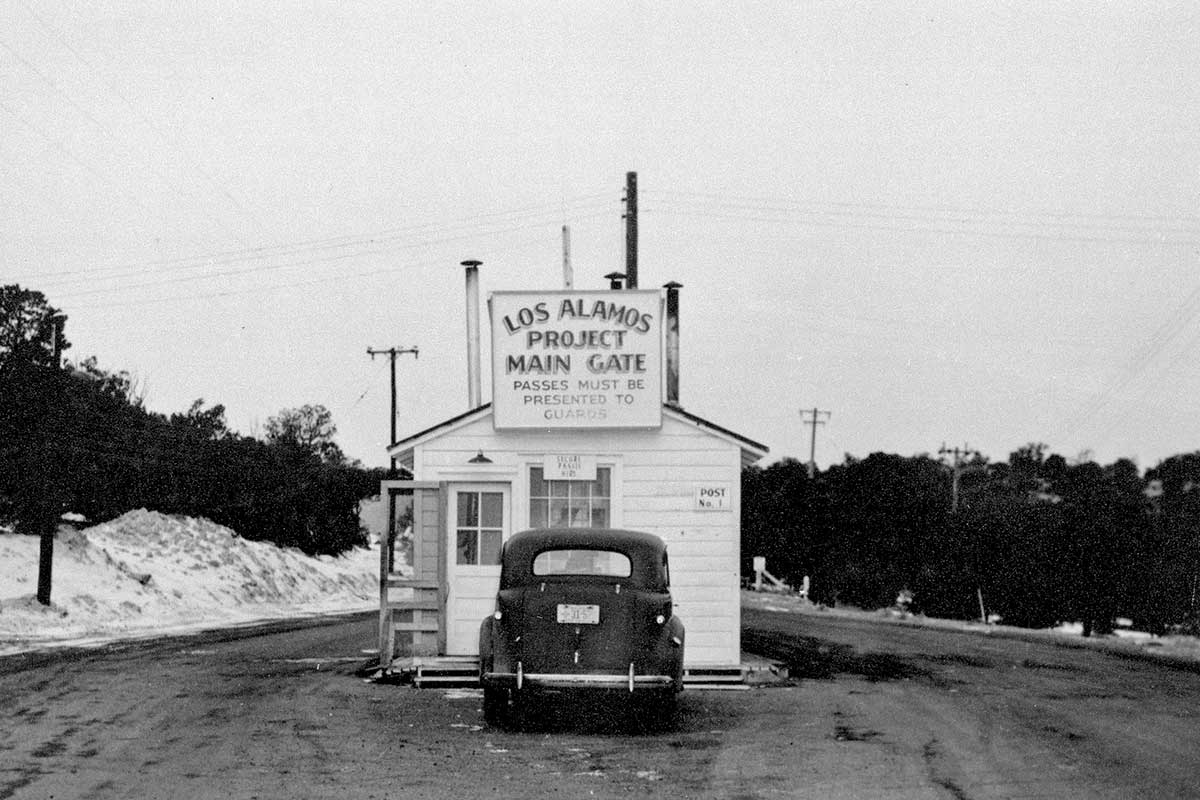 Main
gate at Los Alamos
Main
gate at Los Alamos
The gripping film flows smoothly, comprehensively. It opens in Cambridge,
1998, with witty, introspective and ever-feisty Joan interviewing Ted.
When he arrived at remote Los Alamos, physicist Robert Oppenheimer was
the scientist in charge but the whole Manhattan Project was under the
military with General Leslie Groves, a hawk, in charge. There were no
sidewalks and one waded through the mud. Oppenheimer made a deal with
Groves: you get your request to recruit younger scientists into the
army (less pay), and you get some streets and sidewalks paved.
Ted hated the army and its uniform, but he had no choice.
Besides Joan, there are many interviews: her daughters, Sax’
children, the authors of Bombshell: The Secret Story of America’s
Unkown Atomic Spy Conspiracy (1997) Joseph Albright and Marcia Kunstel,
and co-author of To Win a Nuclear War: The Pentagon’s Secret War
Plans Daniel Axelrod.
Actors portray the loving couple and their friend Saville in several
re-enactments narrated by Joan and Ted.
In one tape interview, Ted tells Joan: The Russians were warm, helpful,
charming, even funny; not authoritarian at all. They agreed on how to
conduct communication, which went on for nearly two years.
When the Los Alamos test occurred, July 16, 1945, most of its creators
partied. Ted kept to his room, however, away from the cheering party-makers,
glad to see that their bomb worked.
The ally leaders were at the Potsdam Conference: Truman, Stalin and
Churchill plus Clement Attlee, who had just overwhelmingly beat Churchill
for the prime minister post. They were planning how to divide Europe
post-war, and Stalin reiterated to Truman the agreement with Roosevelt
at Yalta that he would send Russian troops to help defeat Japan. That
was not what Truman wanted. He planned to use the atomic bomb, in large
part to prevent the Russians from sharing victory. The Soviets, however,
kept their promise and sent nearly one million troops to Japan arriving
as Truman pushed the atomic buttons.
Manhattan Project Scientists
Many Manhattan Project scientists did not want the bomb to be dropped
on Japan, especially on civilians. When General Groves told a few top
scientists about that plan, one of them, Josef Rotblat resigned. Albert
Einstein and Danish physicist-philosopher Niels Bohr, who had received
the 1922 Nobel Physics Prize, wanted FDR to share bomb information with
the Soviets.
Bohr had fled Denmark early in the war upon learning that occupying
Nazi forces were about to arrest him. He became part of the British
component in the Manhattan Project. Bohr encouraged both Winston Churchill
and Franklin D. Roosevelt to share knowledge. Churchill and Roosevelt
viewed him as crazy or naïve. FDR had the FBI surveil him.
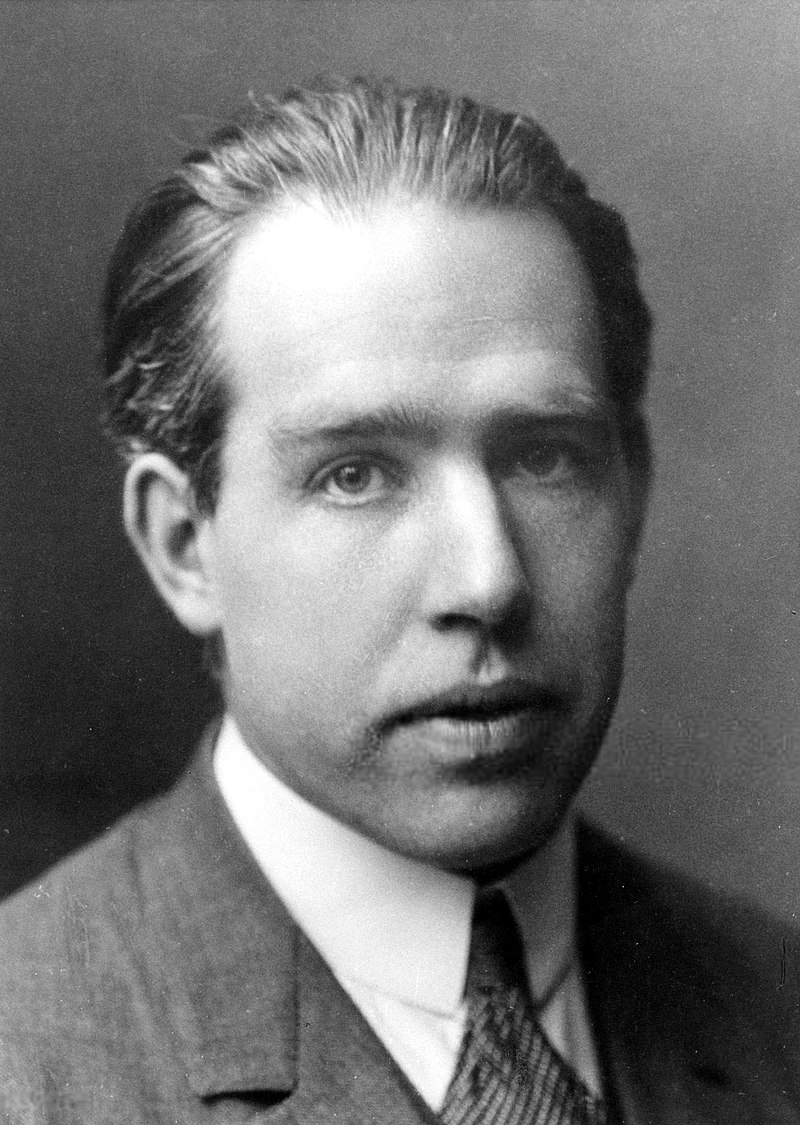
Nobel winner physicist Niels Bohr
(Churchill, in fact, was soon to develop his own plan—Operation
Unthinkable—formulated just after the war ended in Europe. He
sought to use captured but rearmed German troops and British troops
to invade Eastern Europe cities under Soviet control, and bomb three
cities in Russia with Truman’s atomic bombs. Truman said they
had to wait as he had only enough for Japan.)
A number of other nuclear scientists wrote a letter to President Truman
asking him not to drop the bomb on civilians but to invite Japanese
leaders to watch the upcoming test and thus encourage a surrender. They
gave the letter to General Graves, who decided not to send it the president.
Even the most hardened U.S. top generals did not want the bomb dropped.
They had just finished firebombing and devastating 64 cities. They knew
first hand Japan was finished.
U.S. commander in Europe, Dwight D. Eisenhower explained:
“Secretary of War Simson visited my Secretary of War headquarters
in Germany, [and] informed me that our government was preparing to drop
an atomic bomb on Japan. I was one of those who felt that there were
a number of cogent reasons to question the wisdom of such an act—dropping
the bomb was completely unnecessary. I [also] thought that our country
should avoid shocking world opinion by the use of a weapon whose employment
was, I thought, no longer mandatory as a measure to save American lives.
It was my believe that Japan was, at that very moment, seeking some
way to surrender with a minimum loss of ‘face’. The Secretary
was deeply perturbed by my attitude…” Key Issues: Nuclear
Weapons: History: Pre Cold War: Hiroshima and Nagasaki: Eisenhower's
Opinion on the Atomic Bomb (nuclearfiles.org)
Generals Douglas MacArthur and Curtis Le May had just bombed nearly
all Japanese cities. They both held the same view as did Eisenhower.
Furthermore, its use could lead to further nuclear proliferation. Nine
countries now possess nuclear bombs, and some extremist terrorist jihad
organizations seek them.
Despite all the protests and evidence that there was no need, Truman
held fast. He claimed the bombing would save 20,000 American soldiers
lives by not having been killed in battle. We don’t know how he
came to that figure, but it was too low to justify the hundreds of thousands
of civilians killed by the two atomic bombs. Within a few years, propaganda
had fabricated a figure of one million lives saved.
Truman, and other U.S. chiefs, learned from their main propagandist
Nazi enemy, Joseph Goebbels. To win over the masses tell a lie, a big
lie, repeat it everywhere over and over. You win.
As Joan says in the film: "The public is not taught to think.
They form opinions as told by the mass media and at schools."
Film Sequences
The shattering information about U.S. cruelty towards Japanese civilians,
and its ruthless genocidal plans to decimate millions of the 193 ethnic
peoples in Russia is supported in the film by archive newsreels, declassified
information. We see that major bank owners-CEOs and weapons industrialists
urged Truman to take over the Soviet Union (15 republics), in order
to engorge Wall Street profits.
In contrast, wartime government propaganda and media was quite favorable
towards the Soviets. They were suffering many millions of deaths, and
after three years of German Nazi troops and Axis ally Finnish troops
occupying much of Russia and Ukraine, the Soviets were turning the tide.
Besides many favorable newsreels, Mission to Moscow is a 1943
film based on a 1941 book by the former U.S. ambassador to the Soviet
Union, Joseph E. Davies. The film used clips from that government-funded
Hollywood film to chronicle Davies experiences in the USSR, in response
to Franklin D. Roosevelt who wanted the book and film made. The book
sold 700,000, and was translated into 13 languages.
On February 14, 1945, just three months before the end of the war in
Europe, Life magazine ran a favorable cover story of the Soviet Union,
how well people lived, how much they suffered under the war and how
brave they were.
The war tally
The war caused between 70 and 85 million deaths (ca. 3% of the world’s
population) and untold numbers of seriously wounded. Soviet Union and
China citizens accounted for half of deaths.
The Chinese lost between 15-20 million, ca. 3-4% of its population.
The Soviets lost 16-18 million civilians, and 9-11 million soldiers
ca. 14% of its population. A similar number seriously wounded. It lost
70,000 villages, 1,710 towns and 4.7 million houses. Of the 15 countries
in the SU, Russia lost 12.7% of its population: 14 million, just over
half were civilians. Ukraine lost nearly seven million, over five million
civilians; a total of 16.3% of its population.
The U.S. lost just 12,000 civilians, 407,300 military=1/3 of one percent
of its population. England lost just 1% of its population. World War
II casualties - Wikipedia.
Within a year of Life magazine’s praise, several nuclear war operations
were in the works, among them Operation Dropshot. Although the U.S.
dropped that plan did not give up on first strike nuclear war against
the S.U.
In 2015, the National Security Archive, located at George Washington
University, published declassified government files revealing that in
1956, after trashing its earlier plans to drop atomic bombs on Russia,
the U.S. planned to employ the new hydrogen bomb against the populations
of the Soviet Union, Eastern Europe and China.
“Plans to target people violated international legal norms. (The
Air Force Strategic Air Command) wanted a 60 Megaton bomb, equivalent
to over 4,000 Hiroshima atomic weapon. “Strategic Air Command
Declassifies Nuclear Target List from 1950s (gwu.edu)”.
What plans do they have today?
Meeting Joan
After the war, Ted enrolled in the University of Chicago to earn a doctorate
in bio-physics. Then 20, he meet Joan, 17, who was taking general courses
at the university. Saville was also there. The three were good friends,
and bother were initially in love with Joan.
One day, cuddling on a bare wooden floor, listening to Mozart, Ted asked
Joan to marry him. Yes. Joan had otherwise thought she’d wait
to marry until 28, but she couldn’t resist Ted. However, he had
one catch. He had to tell her what he had done with his Los Alamos work.
Only Saville knew. She had to swear to secrecy. Joan listened and felt
proud of him. (Her grandparents were Russian Jews). Then, she recalls,
they went back to what they were doing on the floor.
They got married, and joined the Communist Party. They viewed Chicago
communists as good people, supporting black people and unions, and world
peace. Ted later pioneered important techniques in X-ray microanalysis,
and kept in contact with the NKVD at their suggestion so they could
get him out of the U.S. if he were to be in danger.
Ted and Joan were happy. Ted doing important work, getting graduate
degrees, immersed in love.
Then the FBI came knocking.
Venona Project
The U.S. Army’s Signal Intelligence Service Venona project (precursor
to the National Security Agency) decrypted some Soviet messages. In
January 1950, they uncovered two cables, one identifying Hall and Sax,
and another Klaus Fuchs, as Soviet spies. Until the encrypted document’s
public release in early 1995, nearly all of the espionage regarding
the Los Alamos nuclear program was attributed to Klaus Fuchs. He had
been arrested in Britain by national intelligence MI5. He caved in during
interrogation to protect his sister from arrest. Fuchs served nine of
a 14-year sentence, and went to live in East Germany.
Dave Lindorff, writing in The Nation magazine on January 4, 2022, obtained,
on appeal in 2021, through the Freedom of information Act, the FBI file
for Ted’s 11-year older brother Edward Nathaniel Hall. The Air
Force needed to protect Ed Hall so he could continue with his rocket-making
science. He was the father of the Inter-continental Ballistic Missile
(ICBM) program and Minuteman missile. One Brother Gave the Soviets the
A-Bomb. The Other Got a Medal. | The Nation
The 130-page FBI file on Ed Hall included communications between FBI
Director J. Edgar Hoover and the head of the Air Force Office of Special
Investigations, Gen. Joseph F. Carroll, a former FBI agent. The file
shows how Carroll blocked Hoover's intended pursuit of Ted Hall and
Saville Sax, fearing that Hall's arrest would have, in the political
climate of the McCarthy Era, forced the Air Force to lose their top
missile expert, Ted’s brother.
Instead, the Air Force promoted Ed Hall to Lt. Colonel and later Colonel,
and stopped the FBI from arresting any of them. The FBI also needed
to keep the Soviets in the dark about how the U.S. had broken the Soviet
encrypted code. So, the FBI settled for a one-time interrogation of
Ted and Saville, in March 1951, which the two stone-walled. They tried
again with Ted a few days later, but he just walked away as agents looked
on. The FBI then kept a rather low-key surveillance of Ted and Joan,
and Saville, which included tapping the Halls’ telephone.
The day after Ted and Saville had been interrogated, and the Air Force
had asked Ed what he knew about Ted, Ed came to visit Ted and Joan.
A telephone “repairman” was “fixing” their phone,
which was not broken. Ed detected the bug.
Ed and Ted simply shared that they had been questioned. Ed did not ask
if Ted had done anything. Ed died in 2006, seven years after his brother.
Ed had known since Bombshell was published what Ted had done, but he
never criticized him for his action.
 Ed
(left) and Ted Hall in California, 1979
Ed
(left) and Ted Hall in California, 1979
After earning his PhD, Ted and Joan felt they had to flee the FBI. Ted
left the University of Chicago's Institute for Radiobiology and Biophysics
to do research in biophysics at Memorial Sloan-Kettering in NYC.
Driving to a party of Ted’s work colleagues, they passed by Sing
Sing Prison where, it turned out, Ethel and Julius Rosenberg were to
be executed that day. Julius had allegedly been involved in transmitting
some Manhattan Project information to the Soviets, although he did not
work there.
Ted later reflected with Joan that he felt remorseful. He thought he
should turn himself in to save the Rosenbergs. Joan did not waver.
“The authorities, she told her husband, would simply have taken
you away from me and the children, and continued the execution of Ethel
and Julius.”
Ted knew his wife was right.
Ted and Joan had three daughters in the 1950s: Ruth, Debbie and Sara.
Years later in Cambridge, Debbie died when a truck driver hit her bicycle.
Joan, who became a poet and artist, read one of her poems about Ted
in the film.
What IF
What If
What if I had died instead
and left you here behind
alone in your eighties?
How would you have lived
Would you have solved the riddle
of quannum mechanics?
Of course you’d have kept the audio
system in working order, go on
listening to your music.
Always a better housekeeper than I, you’d
have kept things much tidier. Though
come to think of it when I recall
the state of your study I sometimes wonder.
And would you have learnt to cook?
Frozen ready meals, I suppose.
But no doubt you’d have been invited
to dinner every day by one or another
of your women friends, who once
were my women friends. How would you
have remembered me? Anyway, soon
you’d surely have married again, one
of those women who loved you and envied me.
And for long years of Indian summer you
would drive along together and talk
in the car and in bed, my grey ashes melted
silently into the earth under that tall tree
in the park. Ah, now I’m jealous.
I want to be your second wife.
Their children were attending schools in Connecticut where they lived
during the 1950s. In 1962, Ted and Joan decided to move to Cambridge,
to get away from the anti-Red hysteria in the U.S. Ted had been offered
a research position by Vernon Ellis Cosslett’s electron microscopy
research laboratory at Cambridge University in England. Ted created
the Hall Method of continuum normalization, developed for the specific
purpose of analyzing thin sections of biological tissue.
Joan went to Cambridge College to learn the Russian language and its
literature, and Italian. She soon taught Italian at the college, and
substituted in Russian, for the next 20 years.
When some Venona files were released in 1995, Joseph Albright and Marcia
Kunstel wrote Bombshell: The Secret Story of America’s Unknown
Atomic Spy Conspiracy. This was the first public exposure about
these whistle-blowing spies. Written in 1996, it was published in 1997.
The mass media encircled Ted and Joan’s house in Cambridge. He
was maligned by the media as a traitor. Steven T. Cohen, father of the
neutron bomb, and a good friend of Ted’s at Los Alamos, turned
on Ted and said in one film about atomic spying that he should be recalled
to the Army, court marshalled and executed.
In a never aired portion of 1998 CNN TV-series “Cold War”,
used in the film, A Compassionate Spy, Ted Hall stated:
“I decided to give atomic secrets to the Russians because
it seemed to me that it was important that there should be no monopoly,
which could turn one nation into a menace and turn it loose on the world
as ... Nazi Germany developed. There seemed to be only one answer to
what one should do. The right thing to do was to act to break the American
monopoly.”
Asked in another interview, what motivated him to share information,
Ted pondered, and simply replied: “compassion.” Towards
the end of A
Compassionate Spy, Joan says, “The arms race was a farce
at the expense of the American people and the world. First nuke strike
was the U.S. goal.”
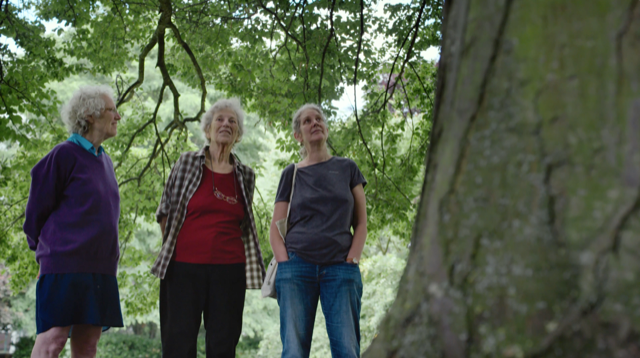 Ruth
(l), Joan and Sara stand by Ted's favorite tree (common beech) near
their home. His ashes are buried by the tree. Joan will lie beside him.
(Photo, "A Compassionate Spy")
Ruth
(l), Joan and Sara stand by Ted's favorite tree (common beech) near
their home. His ashes are buried by the tree. Joan will lie beside him.
(Photo, "A Compassionate Spy")
Steve James, in an interview in Cambridge following England’s
premiere of the film, said, “The threat of nuclear warfare remains.
None of the nine nuclear powers signed the United Nation’s 2021
treaty to ban nuclear weapons.”
Only Soviet-Russia’s President Mikhail Gorbachev had sought dismantling
all nuclear weapons in the 1980s, and wanted to join NATO as partners,
a proposal rejected by the Pentagon, CIA, and President Ronald Reagan.
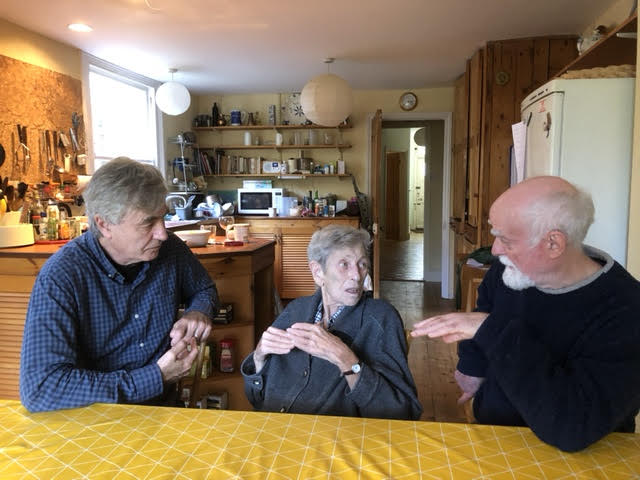 Photo of Joan Hall’s kitchen in Cambridge by Jette Salling
Photo of Joan Hall’s kitchen in Cambridge by Jette Salling
Steve James, Joan Hall, and Dave Lindorff talk at the day after the film showing. During end-of-film comments, Dave said Ted deserved the Nobel Peace Prize posthumously. Coincidentally, photographer Jette Salling had earlier suggested that we present a Peace Lilly to Joan at the film showing.
Ted died November 1, 1999, of Parkinson's disease and renal cancer.
He likely acquired cancer precursor elements from the plutonium he had
worked with to make the atomic bomb.
-----
First published December 2, 2022 at:
https://covertactionmagazine.com/2022/12/02/can-an-american-scientist-who-smuggled-critical-nuclear-secrets-to-the-russians-after-world-war-ii-be-considered-a-good-guy-new-film-says-yes/
Copyright © 2006-2012 Ronridenour.com